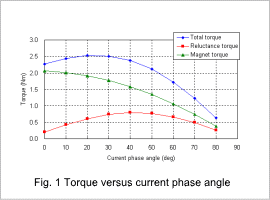*Please prepare a license ID and password for the license administrator.
*It is different from the service for JMAG WEB MEMBER (free membership). Please be careful.
Overview

IPM motors are often used as high performance motors because they are highly efficient and their structure makes it possible to achieve a wide range of operation. They are able to achieve high efficiency because they obtain maximum total torque by using their controls to adjust their magnet and reluctance torques. For this reason, it is important to find out the distribution of both of these torques during operation when the IPM motor is being designed. The motor’s detailed geometry and the material’s nonlinear magnetic properties need to be taken into account to obtain the torque characteristics, and it is even more difficult to segregate the torque into two components by using manual calculations.
In order to proceed with the design while looking into how much each one contributes, it needs to be studied with an electromagnetic field analysis that uses the finite element method (FEM).
In this Application Note, the torque components are separated and the magnetic flux density distributions created by each magnetomotive force are confirmed.
In order to proceed with the design while looking into how much each one contributes, it needs to be studied with an electromagnetic field analysis that uses the finite element method (FEM).
In this Application Note, the torque components are separated and the magnetic flux density distributions created by each magnetomotive force are confirmed.
Torque Versus Current Phase Angle

Fig. 1 shows a graph of the torque versus current phase angle. As can be seen in the graph, the maximum torque is obtained when the current phase angle is near 20 deg. The magnet torque also takes up a bigger portion of the total torque.
Magnetic Flux Density Distribution, Magnetic Flux Lines

Fig. 2 shows a contour plot of the magnetic flux density distribution and magnetic flux lines.
As can be understood from these figures, it is possible to visualize the condition of the magnetic circuit in addition to segregating the torque values. From these, it is possible to confirm the effects on the torque of each magneto motive force.
As can be understood from these figures, it is possible to visualize the condition of the magnetic circuit in addition to segregating the torque values. From these, it is possible to confirm the effects on the torque of each magneto motive force.


